by Heidi Copeland | Sep 27, 2016
Autumn, which technically started on the 22nd day of September is a good time to FALL back into good nutrition!
Many Florida crops are in season now. According to the Florida Department of Agriculture and Consumer Services (FDACS); avocados, bell peppers, carambolas, cucumbers, grapefruits, guavas, mushrooms, oranges, peanuts, squash, sweet corn, tangerines and tomatoes are Fresh From Florida® this month. Additionally, our local Red Hills Small Farm Alliance’s seasonal produce includes elephant garlic, lemon grass, shiitake mushrooms and ginger root.
As the temperatures begin to drop, the days continue to get shorter, and the produce of autumn starts to appear, take time to incorporate that produce into your daily diets. Try celebrating October with a delicious, quick to prepare Roasted Vegetable Pasta recipe. Alice Henneman, Extension Educator Southeast Research & Extension Center University of Nebraska Lincoln writes a wonderful blog including recipes and tips with the goal of making you hungry for healthy food! You’ll enjoy this recipe so much you will want to make it again and again with whatever is in season!
Roasted Vegetable Pasta
Servings: 4 side dish or 2 large main dish servings
Exact amounts aren’t needed in this recipe. Just keep the vegetables being roasted at one time to an amount that can be spread in a single, even layer on a pan in the oven.
Ingredients
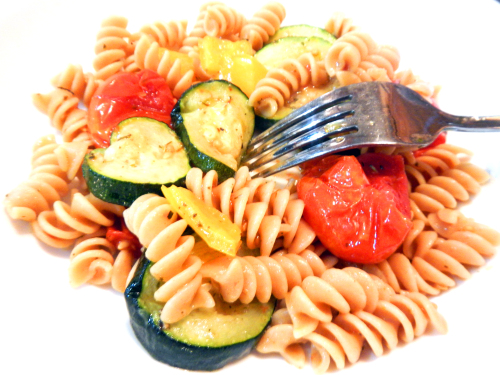 2 to 4 cups cherry tomatoes, left whole with skins
2 to 4 cups cherry tomatoes, left whole with skins- One large bell pepper (any color), cut into 1-inch pieces
- 1 to 2 medium zucchini, cut into 1/4-inch slices
- 3 tablespoons extra virgin olive oil
- 1 teaspoon Italian seasoning
- 8 ounces uncooked pasta (preferably whole grain), such as rotini, farfalle (bow tie shaped) or medium-sized shell pasta
- Salt and pepper (preferably fresh ground pepper) to taste
- Grated Parmesan cheese, preferably freshly grated (optional)
Directions
- Preheat oven to 375 degrees F.
- Mix together cherry tomatoes, bell pepper slices, zucchini and extra virgin olive oil in a large roasting pan, a 9 x 13-inch baking pan or a baking sheet with sides. Spread the vegetables in a single, even layer on the pan. Use a larger pan or a couple of pans if necessary to prevent stacking the vegetables.
- Sprinkle the Italian seasoning over the vegetables.
- Roast for 25 to 35 minutes, until the tomatoes and zucchini are softened and the pepper has started to brown.
- Meanwhile, cook the pasta according package directions. Drain, reserving about 1/2 cup of the pasta water.
- Combine the roasted vegetables with the pasta in a large mixing bowl. Season to taste with salt and pepper. If needed, add reserved cooking liquid by the tablespoonful until you have added enough liquid if pasta requires additional moistening.
- Transfer to a serving dish. Serve and pass the grated Parmesan if desired.
Alice’s Tips
- If you decide to use the recipe for 2 main-dish servings, include the cheese to add some protein to the meal. Or, you might quickly heat some pre-cooked shrimp according to package directions and add to the pasta dish.
Used with permission from: Alice Henneman, MS, RDN, University of Nebraska–Lincoln Extension Educator. For more recipes and tips for fast, healthy and delicious foods, visit https://cookitquick.org/
by Heidi Copeland | Aug 28, 2016
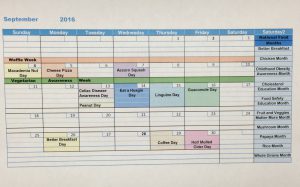
The University of Nebraska – Lincoln (UNL) provides a monthly Calendar of Food Days, Weeks, and Months plus provides resources for selected national food-themes. http://food.unl.edu/september-food-calendar
The month of September boasts a variety of activities using produce that can be grown somewhere in Florida. In fact, many crops are grown locally and are in season now. According to the Florida Department of Agriculture and Consumer Services (FDACS), avocados, carambolas, grapefruits, guavas, mushrooms, oranges, peanuts, and tangerines are Fresh From Florida® this month. http://www.freshfromflorida.com/content/download/16800/269959/09September.pdf In addition, local Red Hills Small Farm Alliance’s seasonal produce includes arugula, Asian greens, eggplant, garlic, okra, southern peas, peppers, radishes, summer and winter squash, figs, Muscadine grapes, pears, and persimmons.
It is easy to incorporate more fruits and vegetables into our diets. Try celebrating September with Vegetarian Awareness Week and consume any of the aforementioned produce, as well as peanuts on National Peanut Day, which is on September 13th.
Peanuts are actually legumes, and can easily fit into many meal plans. Additionally, they are considered a quality protein source for vegetarians. And, according to the Peanut Institute “While ‘nut’ is in their name, peanuts actually grow underground, as opposed to nuts like walnuts, almonds, etc. that grow on trees and are sometimes referred to as tree nuts”.
Peanuts, along with beans and peas, belong to the single plant family, Leguminosae. Leguminosae, commonly referred to as legumes are edible seeds that are enclosed in pods. These plants provide an excellent source of concentrated protein plus, peanuts are rich in vitamins, minerals and phytonutrients, and contain mostly good fats and fiber.
It is fun (and healthy) to experiment with local, fresh Florida produce anytime of the year, and why not have a delicious time this September celebrating a food recognition day, a food awareness week or even an entire month by incorporating Florida fresh foods into your daily, weekly, and monthly meals?
Below is a recipe for a savory peanut sauce, which is very versatile for vegetarian meals and meals with meat or fish. Some ideas for using peanut sauce include:
- Over noodles
- As a dipping sauce for vegetables or spring rolls
- As a baste or condiment for chicken, pork, beef , fish or tofu
- In a stir fry
- In a wrap
- In a slaw
INGREDIENTS
- ¾ cup creamy peanut butter
- ¼ cup rice vinegar
- ¼ cup water
- ⅓ cup reduced sodium tamari or reduced-sodium soy sauce
- 3 tablespoons honey or agave nectar
- 1½ teaspoons grated fresh ginger or ½ teaspoon ground ginger
- 1 to 2 medium cloves garlic, pressed or minced, to taste
- ¼ teaspoon red pepper flakes, plus more for sprinkling
- Optional garnishes: sprinkling of chopped roasted peanuts and additional red pepper flakes
- INSTRUCTIONS
- In a 2-cup liquid measuring cup or medium-sized mixing bowl, whisk together the ingredients until well blended. If your peanut butter is particularly thick, you may need to add a bit more water to thin out the mixture (adding water will mellow out the flavor as well).
- Feel free to adjust to taste here—for example, sometimes I want my sauce more savory and add another clove of garlic, or a little sweeter, so I add extra honey.
- If you’re serving the sauce as a party dip, transfer it to a serving bowl and sprinkle with chopped peanuts and red pepper flakes for some visual interest!

by Heidi Copeland | Jul 29, 2016
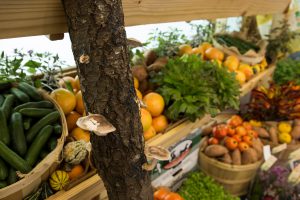 As much as I wanted to write about Sneak Some Zucchini Onto Your Neighbors’ Porch Day, celebrated on August 8, it was difficult because zucchini, a summer squash, takes a two-month hiatus during July and August, the warmest Florida summer months. Nevertheless, there is quite a variety of produce growing locally (within 100 miles) of this Capital City and it is amazing! While the Florida state produce calendar boasts eight “Fresh From Florida” seasonal products, local growers produce almost double that amount. Nearby, arugula, sweet corn, eggplant, garlic, okra, southern peas, peppers of all kinds, winter squash, cantaloupe, figs, Muscadine grapes, pears, and watermelon are generally available here, now. As popular as shopping and eating locally are becoming, it is important to know what grows in this area and when it is ready, as nothing beats fresh produce.
As much as I wanted to write about Sneak Some Zucchini Onto Your Neighbors’ Porch Day, celebrated on August 8, it was difficult because zucchini, a summer squash, takes a two-month hiatus during July and August, the warmest Florida summer months. Nevertheless, there is quite a variety of produce growing locally (within 100 miles) of this Capital City and it is amazing! While the Florida state produce calendar boasts eight “Fresh From Florida” seasonal products, local growers produce almost double that amount. Nearby, arugula, sweet corn, eggplant, garlic, okra, southern peas, peppers of all kinds, winter squash, cantaloupe, figs, Muscadine grapes, pears, and watermelon are generally available here, now. As popular as shopping and eating locally are becoming, it is important to know what grows in this area and when it is ready, as nothing beats fresh produce.
Perhaps you are interested in saving some of the August harvest. Nearly all vegetables can be frozen, provided a few simple procedures are followed. Freezing does not sterilize foods like pressure canning does. However, freezing does delay the growth of microorganisms and slows down chemical changes that affect vegetable quality; there also will be textural changes during freezing.
Blanching – scalding vegetables in boiling water for a short period of time – is an easy process to inactivate the enzymes in the vegetable skin and to destroy microorganisms on the vegetable surface. Plus, blanching reduces the vegetable in size a bit so it does not take up as much room in the freezer. Blanching time is crucial and varies with vegetable and size.
Cooling is critical, too. Vegetables should be cooled quickly and thoroughly to stop the cooking process. To cool, plunge the vegetables immediately into a large quantity of cold water or ice water for about the same amount of time as blanching. Drain vegetables thoroughly after cooling; promptly and properly package, label, and place in the freezer. Freezing is an easy and convenient food preservation method that allows you to enjoy food in the future.
If you are looking for something that tastes good and is good for you, try a vegetable medley with all the vegetables you can freeze. A medley mixes fresh, frozen, or a combination of both vegetables for a dish that takes a short time to prepare, can be eaten hot or cold, frozen for future use, or even added to a stock for a flavorful vegetable soup.
If you are one of the lucky ones gifted with an abundance of produce from the farm, garden, or friends, all of the vegetable ingredients in the recipe below can be frozen as single ingredients or in pre-measured amounts to help you quickly whip up a batch of summer fare.
Summer squash, like zucchini and crookneck squash, might be taking a break during these dog days of summer, but soon they will be fruitful again, proliferating by the bushel basket.
By using the aforementioned techniques, try saving some of what is in season today to add to what will be growing shortly!
VEGETABLE MEDLEY
Ingredients
1/4 cup olive oil (or less)
1 cup onion (diced – does not need blanching)
2 garlic cloves (smashed, minced – do not need blanching)
2 cups bell pepper (red, green or yellow, diced – does not need blanching)
2 cups zucchini (1/2 inch slices; blanch 3 minutes)
2 cups Crookneck (1/2 inch slices; blanch 3 minutes)
3 cups lima beans (blanch for 2 to 4 minutes)
3 cups corn kernels (fresh: blanch whole ear for 4 minutes before removing from the cob)
2 tablespoons favorite herb (parsley, basil, rosemary…even mint, coarsely chopped)
Directions
- In a skillet over medium-high heat, add oil.
- Add onion; cook until translucent (2 minutes). Add garlic, bell peppers, zucchini, squash, lima beans, and corn.
- Season as desired; cook, stirring, until vegetables are tender (10 minutes). Stir in seasoning and serve warm or cold or even freeze to use at a later date.
For more information about proper freezing techniques, see University of Nebraska-Lincoln, http://food.unl.edu/freezing.
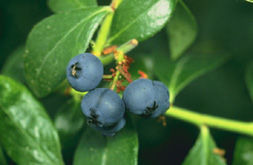
by Heidi Copeland | Jun 29, 2016
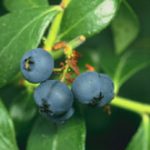 July is National Blueberry Month and what a great testament it is to be named fruit of the month during this patriotic season! Blueberries are one of the few fruits native to North America and have been enjoyed for centuries, both wild and cultivated. In fact, the United States is the world’s largest producer of blueberries. Although Florida has hundreds of small blueberry farms across the state, Michigan still leads the pack in national blueberry production.
July is National Blueberry Month and what a great testament it is to be named fruit of the month during this patriotic season! Blueberries are one of the few fruits native to North America and have been enjoyed for centuries, both wild and cultivated. In fact, the United States is the world’s largest producer of blueberries. Although Florida has hundreds of small blueberry farms across the state, Michigan still leads the pack in national blueberry production.
Nonetheless, blueberries are an important agricultural crop as well as a nutritional powerhouse. Blueberries are the fruits of a shrub, they grow in clusters, and range in size from that of a small pea to a marble. Blueberries are deep in color, ranging from blue to purple-black, and feature a white-gray waxy “bloom” that covers the berry’s surface and serves as a protective coat. The skin surrounds a semi-transparent flesh that covers tiny seeds.
Blueberries are low in calories (84 per cup), high in fiber (4 grams per cup), and full of antioxidants, vitamins, and minerals. Additionally, blueberries taste delicious, producing flavors that range from mildly sweet (cultivated) to tart and tangy (wild).
When purchasing (or picking), choose blueberries that are firm and have a uniform color. Avoid berries that appear dull in color or are soft and watery in texture.
Before refrigerating blueberries, remove any damaged or moldy berries to prevent the rest from spoiling. Don’t wash berries until right before eating, as washing introduces moisture, which speeds up the decaying process.
If you plan to freeze your blueberries, don’t wash before freezing, as washing can make their skins tough. Instead, simply pack your blueberries into a freezable container, seal, and freeze.
An alternative way to freeze blueberries that may make the fruit easier to remove from the container is to simply spread a single layer of prepared berries on shallow trays and freeze (lining the pan with a piece of parchment paper works well here, too). When frozen, strike the tray on a counter, then promptly and properly package, label, and return the blueberries to the freezer. The fruit pieces will not stick together, and small quantities of blueberries can be removed easily for use, but be sure to wash the thawed berries prior to use.
Most frozen fruits maintain high quality for eight to twelve months at 0°F or below. Unsweetened fruits lose quality faster than those packed in sugar or syrup. Longer storage will not make the food unfit for use, but may impair its quality. As with all frozen foods, it is a good idea to use the FIFO method (First In, First Out) when taking out of the freezer.
Blueberries are not just for pie anymore. Branch out a bit. The Florida Blueberry Growers Association has a database of recipes for drinks, breakfast foods, breads, appetizers, salads, dressings, sauces, entrée items, and desserts.
Just like summer… blueberries are full of endless possibilities. Try some today!
Check out these other Fresh from Florida items in season in July: http://www.freshfromflorida.com/content/download/16798/269945/07July.pdf
BLUEBERRY SALSA
Ingredients:
- 2 cups fresh blueberries
- 1 cup finely diced fresh Florida mango
- 1 cup finely diced fresh Florida cantaloupe
- 1 cup finely diced fresh Florida watermelon
- 1 jalapeno pepper, seeds and membrane removed, minced
- 2 to 3 tablespoons lime or lemon juice, divided
- 1/2 teaspoon lime zest
- 3 tablespoons chopped cilantro
- 1 garlic clove minced
- 1/4 cup diced red onion
- Salt as needed
Directions:
- Combine the fruit, jalapeño, 2 tablespoons of the lime juice, lemon or lime zest, cilantro and red onion.
- Season with salt and additional lemon or lime juice as needed.
- Serve with tortilla chips or as an accompaniment to fish or chicken.
by Heidi Copeland | Jun 12, 2016
What’s in season now? Although summer doesn’t officially start for a few more weeks farmers have been busy producing seasonal, summer fruits and vegetables. The seasonal vegetable guide for North Florida Produce has an abundance! Not only are basil and beans plentiful, so are blackberries, blueberries and mulberries, corn, cucumbers, eggplant, garlic, melons, okra, peas (southern) peppers, summer squash, and tomatoes. (in the southern part of Florida avocado, guava, lychee, mango, papaya, and passion fruit are showing up)
Fruits and vegetables are loaded with great vitamins and minerals! And eating at least 3-5 servings a day of fruits and vegetables is truly considered the key to good health. Folks who eat a wide variety of colors – both fruits and vegetables, as part of an overall healthy diet, are likely to have a reduced risk of some chronic diseases. Both fruits and vegetables provide nutrients vital for health and maintenance of your body.
Eating fruits and vegetables is easy to do!
Have you ever tried using the United States Department of Agriculture What’s Cooking? USDA Mixing Bowl recipe finder? Using this website, I simply checked the box that I’d like to focus on, eating more fruit and vegetables then added the ingredient zucchini to the recipe search box. http://whatscooking.fns.usda.gov/ 
Sixty recipes popped up! I choose the one for Squash Squares.
Squash Squares: Ingredients
4 eggs (beaten lightly)
1/4 cup oil
3 cups thinly sliced squash (use zucchini or yellow squash)
1/4 cup chopped onion
1 cup biscuit mix
1 teaspoon dried parsley (or 2 T chopped fresh parsley)
1/3 cup grated cheddar cheese
1 cup grated carrots
Directions
- Mix all ingredients thoroughly and pour into a greased 9×13″ baking dish.
2. Bake 25 minutes, or until bubbly and brown, in a 350°F oven.
3. Serve in squares while warm.
Notes
- To freeze – Cool, and cut into squares. Freeze squares on a cookie sheet. When they are frozen, put into freezer bags. When ready to use, take out of the freezer bag, place in microwaveable covered container. Reheat in microwave at medium setting.
- Try 8 egg whites in place of whole egg for less cholesterol and fat.
- Add other thinly chopped fresh veggies into the mix – green or red sweet peppers, spinach, broccoli.
I’ve tried this recipe using both yellow squash and zucchini with equally tasty results. I especially appreciated the suggestions on the recipe to personalize by adding your own twist. Like it spicy? Add a jalapeno! Want to add some pizzazz? Add some diced red pepper for color. Want to eat it later? Just freeze and eat or reheat and eat! Don’t have zucchini on hand? Substitute other thinly chopped fresh veggies. I have even substituted the biscuit mix with a corn bread mix for yet another spin.
Fruits and vegetables are nutritious and delicious. Try adding some Florida fresh, seasonal fruits and vegetables to your meals!
 2 to 4 cups cherry tomatoes, left whole with skins
2 to 4 cups cherry tomatoes, left whole with skins





